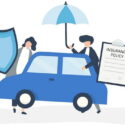All you need to Know about Insured’s Declared Value (IDV) in Vehicle Insurance
IDV in insurance refers to the maximum claim payable by the car insurance company to the insured person. Vehicle IDV is the compensation that the insurance company provides in case of theft or damage to the insured vehicle. For example, if the market value of your car is Rs 10 lakhs then the insurer will reimburse the same amount for total loss or damage as mentioned in the policy wordings.
What is IDV in Car Insurance?
Insured Declared Value or IDV of your car is the value of the vehicle decided by the insured or the policyholder at the time of buying the policy. IDV full form in Insurance is Insured Declared Value. For all those thinking about what is IDV in vehicle insurance, the IDV decides the insurance premium for your vehicle and the amount the owner is entitled to in case of complete or partial loss of the vehicle.
The catch is that a policy buyer cannot declare any value for his vehicle. He needs to take the listed selling price (as per the invoice) and then a specific amount is deducted as depreciation depending on the age of the insured vehicle.
How to calculate IDV?
Insurers cannot randomly decide upon the IDV but should calculate the IDV using a specific formula and the depreciation on parts as applicable.
Here is how to Calculate IDV or the Insured Declared Value of your car:
Insurance Declared Value of a car = (Selling price listed by the manufacturer –applicable depreciation) + (Cost of car accessories – Depreciation on these parts)
*Accessories that are not included in the listed selling price cannot be included.
*Costs incurred on registration and insurance are not payable.
What is IDV Value in Car Insurance?
This means that the Insured Declared Value of your car is simply the ex-showroom price minus the applicable depreciation as per the age of the vehicle. To determine the IDV value, a depreciation table for most of the car insurance policies can be used as below:
| Age of the Vehicle | < 6 months | 6 mo – 1 yr | 1-2 yrs | 2-3 yrs | 3-4 yrs | 4-5 yrs |
| % of Depreciation | 5% | 15% | 20% | 30% | 40% | 50% |
(For reference purpose only. The percentage may vary from one insurer to another)
In case the vehicle is older than 5 years, the insurer decides the depreciation as per the pre-specified terms in the policy.
Depreciation on Car Parts or Components
The depreciation deduction on your car parts as per the Insurance Regulatory and Development Authority of India (IRDAI) is given below:
- For plastic/rubber/nylon/tyres , tubes, batteries, and airbags- 50% depreciation is deducted
- On fiberglass parts-30% depreciation is deducted
- Glass parts- Nil
- On wooden parts-Car’s age-related depreciation is applicable, e.g., 5% in the first year, 10% in the 2nd year and so on
- For painting charges- 50% of depreciation is deducted on the material cost of total painting expenses. In the case of a consolidated bill for painting, material costs are calculated as 25% of the total painting charges.
You can use an IDV calculator to get the correct values.
Motor insurance policies for vehicles are basically of two types i.e. comprehensive and third-party vehicle insurance policy.
Comprehensive Vehicle Insurance Policy
A comprehensive car insurance policy covers all the damages caused to a third-party as well as your own vehicle. Own vehicle expenses covered include repair/damage to your vehicle as well as loss or theft of your vehicle.
Premiums for this type of polices are comparatively higher and are dependent on various factors such as car make and model, type of fuel, its age and depreciation.
A comprehensive car insurance policy should usually cover the following expenses:
- Loss or damage to the vehicle due to natural calamities such as lighting, cyclones, landslides, earthquakes, etc.
- Loss or damage to the vehicle due to man-made calamities such as burglaries, thefts, riots, terrorist activities, etc.
- A personal accident cover up to ₹ 15 lakhs for if any damage, permanent disability or death of the owner-driver (the insured) occurs while travelling, getting in or while getting out of the car
Comprehensive motor insurance does not cover the damages that occur in the following circumstances:
- The driver is driving the car under the influence of alcohol
- The driver is uninsured or does not have a valid driving license
- If the loss or damage to the vehicle is deliberate
- If the damage/ loss is due to vehicle being driven beyond the scope of insurance cover
Third-party Liability Vehicle Insurance Policy
Third-party liability vehicle insurance policy covers only damages to a third party, person or vehicle involved in the accident and incurred damages apart from your vehicle.
While the insured member is the first party, the insurance company becomes the 2nd party, and the person who claims for the damage due to the first party is the third party.
In this policy, damages to the insured’s vehicle are not covered, and naturally, the premium is less.
Premiums for third-party insurance do not depend on the age or depreciation of your vehicle and are decided by the IRDAI. The amount varies as per the make and model of each vehicle. The concept of Insured Declared Value does not apply to this kind of insurance.
Third-party insurance is mandatory for all the vehicle owners in India, in case a comprehensive vehicle insurance policy does not cover the vehicle.
Third-party car insurance covers the following:
- Death or bodily injuries to the third party (person)
- Damage to the property of the third party (vehicle).
Total Loss (TL) and Constructive Total Loss (CTL)
When the damage to the vehicle is so extensive that the damage cannot be repaired and the vehicle cannot be restored to the pre-damage condition, it is called Total loss (TL). These kinds of damages occur in heavy accidents, falls or collisions.
In case the vehicle has met with a major accident and suffered damage, from which it can be repaired and retrieved to the pre-damage condition, but the repair charges exceed 75% of the IDV or market value of the vehicle, it is called constructive total loss (CTL).
In case of a total loss or a CTL, the insurer takes over the damaged vehicle and pays the full IDV of the vehicle after deducting the non-payable expenses. The policy stands cancelled after the TL/CTL claim has been settled. No additional charges are needed to be paid by the insured.
Be wary while buying car insurance, because if you choose the policy with a lower premium, a lower Insured Declared Value could have been quoted for your car. In case of damage, loss or theft, you may not be able to recover what your vehicle is worth.
Hence, an IDV calculator is useful while purchasing a motor insurance policy. Go through the policy wordings carefully, use the IDV calculator, key in the correct age of the vehicle and depreciation and insure the vehicle as per its value.
Buy the policy which gives you the correct IDV even if the premium is a tad higher. Over-insuring or under-insuring your car may decrease its value.
Frequently Asked Questions
Q1. What is the maximum limit to which I can get my car insured? Can I decide the limit of the sum insured?
The maximum amount to which a car, or any vehicle can be insured is not like a life or health insurance where the insured decides the sum insured, term, and starts paying premiums.
Some of the factors that help choose the insurance limit and premiums include
- Fuel used for the vehicle – Petrol/ Diesel/ C.N.G
- Type of registration – Private/ commercial
- Registration location of the vehicle
- Age of the vehicle – Insured Declared Value or IDV/ premium goes down as the age of the vehicle increases.
- The cubic capacity of the vehicle
- Make and model of the vehicle.
- Type and duration of the insurance policy.
Q2.What is the return to invoice cover in car insurance?
‘Return to invoice’ is an add-on to the existing car insurance, which one needs to buy at the time of purchasing or renewing the policy.
In case of a total loss, where the vehicle is damaged beyond repair, the insured is only entitled to an amount up to the Insured Declared Value of the vehicle. If it is a new vehicle that is less than a year old, the IDV amount will not be enough to buy a new vehicle.
With the ‘return to invoice’ add-on, the difference between the Insured Declared Value and the actual invoice price also get paid in case of a total loss of the vehicle, leaving the insured with no loss. But the ‘return to invoice’ add-on is applicable for vehicles only up to 2 years from the date of purchase.
Q3. What expenses/ damages are covered in third-party liability cover in car insurance?
Any losses incurred by the third party or the third party’s property due to the first party (the insured) are liable to be covered by the insurance company.
Q4. What is the difference between the ex-showroom price and on-road price? Which one does a motor insurance policy consider?
Ex-showroom price is the actual cost of manufacturing the vehicle as listed by the seller. It only consists of selling price and includes an additional G.S.T.
When you add the extra mandatory expenses such as registration charges, road tax, green cess tax collected at source (T.C.S), handling/ logistic charges, annual maintenance charges, extended warrant charges and essential accessories, it becomes on-road price which is much higher than ex-showroom price.
The insurer considers only the ex-showroom price. The policyholder can buy an additional ‘accessories cover’ for his vehicle, which covers damage or loss to accessories as well.
Q5. What more should I know about ‘car accessories insurance cover’? Should I buy it or not?
There are 2 types of car accessories insurance covers – Electrical and Non-electrical. Electrical accessories include headlights, fog lights, music system, air-condition etc. Non-electrical accessories are things such as any decorative or protective fittings, alloy wheels, seat covers etc.
Note that accessories such as anti-theft alarms, phone mounts, fire extinguishers, car battery chargers, car cameras are not luxuries, but essentials that ensure the safety and prolong the lifespan of the car.
Hence it is advisable to insure your car accessories. It would also prevent unnecessary expenses as accessories are easier to steal than the car itself.
Q6. I have got my car fitted with a C.N.G kit? Should I inform my insurer about this?
Yes. The insurer will anyways consider the type of fuel used in the vehicle while issuing the policy. But if you install a C.N.G in the middle of the policy year, you must immediately inform the insurer about this, take your vehicle to the insurer along with the new RC and change the type of insurance. Do not hesitate if you need to pay some extra premium. Failing to do this will allow the insurer to deny paying any expenses related to C.N.G kits in case of damage.
Do not forget to insure the C.N.G kit also as any damage or loss to the kit will also be protected.
Q7. What expenses are not covered in a third party liability car insurance policy?
Own damages (OD) that are sustained to the vehicle of the insured (first-party), damage expenses if the driver of the third party vehicle is drunk or does not hold a valid driving license are generally not covered in a third party car insurance.



